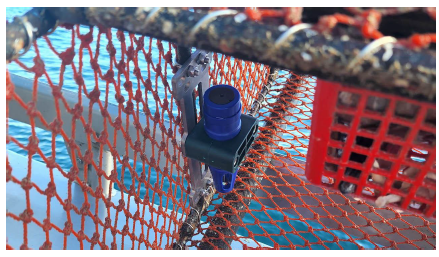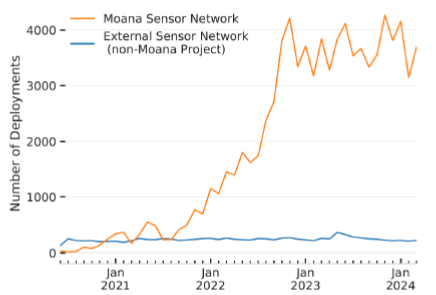Aotearoa Launches New Charitable Trust to Safeguard Ocean Monitoring Network
The landmark Moana Project may have formally concluded in 2024, but its legacy is just beginning. Today, collaborators in the Moana Project (including MetService, ZebraTech, Cawthron and UNSW) proudly announce the transformation of the Aotearoa Moana sensor network into a sustainable, independent, and globally connected initiative under a new charitable trust: the Aotearoa Moana Observing System (AMOS).
Figure 1: Moana Temperature sensor rigged to crayfish trap
Aotearoa New Zealand’s groundbreaking ocean sensor network has entered a new chapter with the launch of the Aotearoa Moana Observing System (AMOS), a charitable trust established to secure the long-term future of the country’s marine monitoring efforts.
The move comes after the conclusion of the government-funded Moana Project in 2024, which pioneered a vessel-based ocean temperature network across New Zealand’s coastal and offshore waters. Through collaboration between MetService, ZebraTech, Cawthron Institute and the University of New South Wales, the project gathered more oceanographic data than any other initiative in New Zealand history.
Over its lifespan, the Moana network collected more than 38 million temperature observations and thousands of vertical profiles—equivalent to more than 128 years of instrument time in the water. The result is a dense nationwide dataset that has strengthened weather forecasting, climate research, fisheries management, and dozens of peer-reviewed studies.
Dr Brett Beamsley of MetService/MetOcean says the scale and continuity of the data is what makes it so valuable.
“A large part of the value of these data is understanding what is happening not just at the surface but throughout the water column, and being able to look at longer-term trends,” he explained. “Having observations spanning years is critical.”
The New Zealand-developed technology has already been adopted internationally, with similar deployments now operating on more than 60 vessels in Australia, fleets in Alaska, Bangladesh, Ghana, Tanzania, and across Pacific Island nations. It has also been incorporated into hurricane forecasting in the Bahamas.
Figure 2: An illustration of the step-change in number of monthly instrument deployments collecting information about the New Zealand marine environment; opening our eyes to changes that are occurring within this poorly monitored environment.
Professor Moninya Roughan from University of New South Wales says fishers are seeing both immediate and long-term benefits.
“They use Moana sensors to make operational decisions at sea, but they also understand the importance of building long-term datasets to manage fisheries sustainably,” she said.
Closer to home, scientists warn that changing ocean temperatures could significantly impact Aotearoa’s fisheries and quota management system. Species may migrate southward or disappear from certain regions altogether if waters warm beyond their tolerance.
“The fishing industry may well be at the forefront of those changes, both positive and negative,” Dr Beamsley said. “It would be a tragedy if this programme was to fall over now that government funding has ended.”
To prevent that outcome, AMOS has been established as an independent trust tasked with maintaining and growing the sensor network. Its founding board includes representatives from Cawthron Institute, MetService/MetOcean, UNSW and ZebraTech.
The trust’s goals include keeping data open and accessible, supporting iwi, community groups, researchers and industry, and ensuring financial sustainability for long-term ocean monitoring.
AMOS estimates it will cost about $50,000 annually to operate the system, not including in-kind support. Some funding has already been secured, and the trust is actively seeking further investment from philanthropy and industry partners.
While agencies such as the Ministry for Primary Industries and the Department of Conservation have recognised the network’s value, direct government funding has not been secured. Instead, AMOS is introducing a modest contribution model for participating vessels—$380 per year per sensor unit, plus $100 for each additional sensor—to cover calibration, data transmission and processing.
Dr Beamsley says the stakes are high
“Marine heatwaves are becoming more common, and there are clearly significant changes under way in our oceans. It is vital to know what is going on in the oceans that sustain us.”
With AMOS now in place, New Zealand’s world-leading ocean monitoring network has been given a sustainable home—ensuring that the insights it provides into climate, fisheries and weather will continue to guide decisions for years to come.
Visit https://amos.org.nz for more information
Full press release here
Figure 3: Marine Heat Wave forecast for West Coast, Auckland. Ocean temperatures are almost 2 degrees warmer than the long-term average for this time of year.



